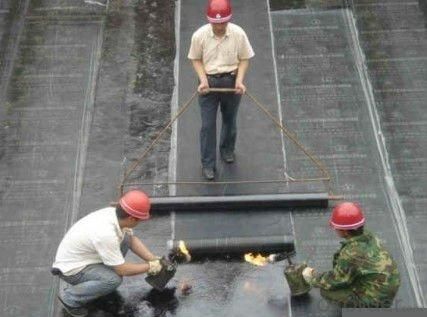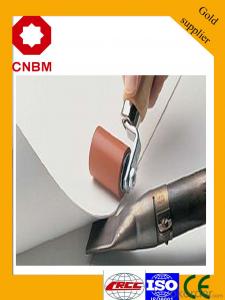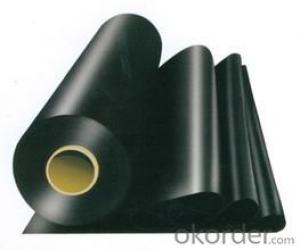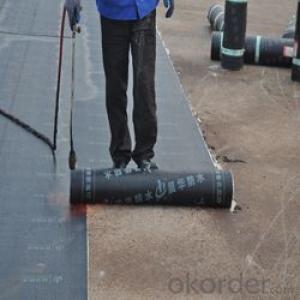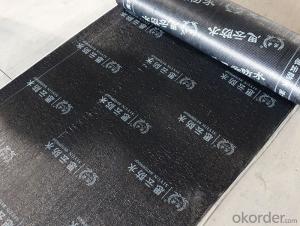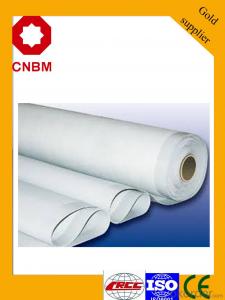SBS/APP modified bitumen waterproof membrane
- Loading Port:
- Qingdao
- Payment Terms:
- TT OR LC
- Min Order Qty:
- 500 m²
- Supply Capability:
- 1000000 m²/month
OKorder Service Pledge
OKorder Financial Service
You Might Also Like
1. Introduction
SBS(Styrene Butadiene Styrene) /APP (Atactic Polypropylene) modified bitumen membrane is
made by saturating the base in bitumen, or thermoplastic elastomer (such as SBS, APP, APAO,
APO), reinforced with polyester or fiberglass, finishing the upward face with polythene
membrane, fine sands or mineral slates (or grains) or etc.
2. Specification
1) Thickness: 3mm, 4mm, 5mm
2) Size: 1m (width)*10m (length) or on demand
3) Base: Polyester felt
4) Surface: PE film, Aluminum foil, Yellow sand, Shale gravel (Schist), Colored sand
5) Self adhesive type
Thickness: 1.2mm, 1.5mm, 2mm, 3mm, 4mm;
With or without polyester felt
Surface: PE film, Aluminium foil, Double-sided adhesive
6) SBS modified bitumen membrane is specially applied in the cold district,
APP modified bitumen membrane is more suitable for hot district with high temperature.
7) Certificate: ISO9001/14001
3. Applications
1) Roof and underground in industrial and civil buildings;
2) Bridge, subway, tunnel, swimming pool, etc.
3) Waste landfill, sewage plant, irrigation system, etc.
- Q: Can a waterproofing membrane be used on roofs with slope?
- Roofs with slope can use a waterproofing membrane. It is commonly applied on sloped roofs to add an extra layer of protection against water infiltration. The membrane is typically placed beneath the roofing materials and acts as a barrier to stop water from seeping into the roof structure. This is particularly crucial for sloped roofs as water runoff is faster and may lead to leaks or damage. The waterproofing membrane is designed to be flexible and is able to adapt to the roof's slope without compromising its effectiveness. Moreover, it also enhances the roof's durability and lifespan by preventing moisture-related problems like rot or mold growth.
- Q: Can a waterproofing membrane be used on chrome surfaces?
- A waterproofing membrane can be used on chrome surfaces, but it may not be necessary or recommended. Chrome surfaces are typically already resistant to water and moisture due to their inherent properties and protective coatings. These coatings provide a barrier against corrosion and prevent water damage. Applying an additional waterproofing membrane on top of a chrome surface may not provide any added benefits and could potentially interfere with the appearance and functionality of the chrome. It is always best to consult the manufacturer or a professional in the field to determine the appropriate treatment for chrome surfaces.
- Q: Can a waterproofing membrane be used on tunnels with communication systems?
- Yes, a waterproofing membrane can be used on tunnels with communication systems. The membrane can help protect the communication systems from water damage and ensure their proper functioning.
- Q: Are waterproofing membranes resistant to mold and mildew?
- Yes, waterproofing membranes are resistant to mold and mildew. They create a barrier that prevents moisture from seeping through, which helps inhibit the growth of mold and mildew.
- Q: Can a waterproofing membrane be used for underground parking structures?
- Yes, a waterproofing membrane can be used for underground parking structures. Waterproofing membranes are commonly used in construction to prevent water infiltration and protect the structure from moisture damage. In underground parking structures, where there is a higher risk of water seepage due to the location below ground level, a waterproofing membrane can be applied to the walls, floors, and ceilings to create a barrier against water intrusion and ensure the longevity and integrity of the structure.
- Q: Can a waterproofing membrane be used in commercial buildings?
- Yes, a waterproofing membrane can be used in commercial buildings. Waterproofing membranes are used to protect various parts of a building, including roofs, foundations, and basements, from water intrusion. In commercial buildings, where there may be a higher risk of water damage due to larger surface areas, increased foot traffic, and complex architectural designs, waterproofing membranes can provide an effective solution. These membranes are designed to create a protective barrier against water, preventing leaks, dampness, and potential structural damage. Additionally, waterproofing membranes can enhance the longevity of the building by reducing the risk of deterioration caused by water exposure. Thus, incorporating a waterproofing membrane system in commercial buildings can help maintain a safe and dry environment, protect valuable assets, and maximize the lifespan of the structure.
- Q: Is a waterproofing membrane resistant to freeze-thaw cycles?
- Yes, a waterproofing membrane is resistant to freeze-thaw cycles. This is because the membrane is designed to prevent the penetration of water, which can expand and contract during freeze-thaw cycles. The membrane acts as a barrier, preventing water from seeping into the structure and causing damage due to freezing and thawing. Additionally, waterproofing membranes are typically made from materials that are flexible and able to withstand temperature fluctuations without losing their effectiveness.
- Q: Can a waterproofing membrane be used in conjunction with warranty or insurance policies?
- Yes, a waterproofing membrane can typically be used in conjunction with warranty or insurance policies. Many waterproofing products and systems come with warranties that provide coverage for a certain period of time, typically ranging from 5 to 20 years or more. These warranties often guarantee the effectiveness and durability of the waterproofing membrane, and may cover repairs or replacements in case of any failures or defects. Additionally, insurance policies may also provide coverage for damages caused by water leaks or flooding. By installing a waterproofing membrane, property owners can mitigate the risk of water damage and potentially reduce their insurance premiums. It is advisable to check with your insurance provider to determine if they offer any discounts or incentives for using waterproofing systems. However, it is important to note that the coverage provided by warranties and insurance policies may vary depending on the specific terms and conditions. It is recommended to carefully review the details of the warranty or insurance policy and consult with professionals to ensure that the waterproofing membrane meets the requirements and specifications outlined by these agreements.
- Q: Does a waterproofing membrane require a protective layer?
- Yes, a waterproofing membrane typically requires a protective layer. The protective layer helps to shield the membrane from various external factors, such as UV rays, weather conditions, mechanical damage, and chemical exposure, thereby enhancing its durability and longevity.
- Q: Can a waterproofing membrane be used for military facilities?
- Yes, a waterproofing membrane can be used for military facilities. Waterproofing membranes are designed to provide a protective barrier against water infiltration, which is essential for preventing damage to structures and equipment. In military facilities, such as barracks, hangars, or command centers, the use of a waterproofing membrane can help ensure the integrity of the building envelope, protecting it from moisture intrusion, mold growth, and potential structural damage. Additionally, a waterproofing membrane can also enhance the durability and longevity of the facility, reducing the need for costly repairs and maintenance over time. Therefore, the application of a waterproofing membrane is highly beneficial for military facilities as it ensures a robust and resilient infrastructure capable of withstanding various environmental conditions.
Send your message to us
SBS/APP modified bitumen waterproof membrane
- Loading Port:
- Qingdao
- Payment Terms:
- TT OR LC
- Min Order Qty:
- 500 m²
- Supply Capability:
- 1000000 m²/month
OKorder Service Pledge
OKorder Financial Service
Similar products
Hot products
Hot Searches
Related keywords


